Anaheim Ducks Early Season Rookie Report Cards

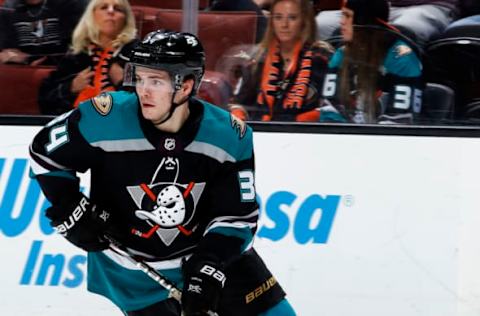
First impressions are not easily forgotten and the Anaheim Ducks had six rookies making their’s this week. Pucks of a Feather contributor, Jonathan Maxfield, spent the week analyzing the Ducklings and is bringing you our early season rookie report cards.
The Anaheim Ducks are in a truly unique situation at the one week point of the NHL Season. The team holds the second-longest active playoff streak in the league at 6 seasons and they’ve been one of the most consistent teams in the league over the past decade. Yet, they find themselves at this point of the season with 6 rookies on the roster. The Anaheim Ducks have never had six rookies on their roster in franchise history!
That many roster spots occupied by rookies are usually reserved for teams that are rebuilding. Detroit, who the Ducks played for their home opener, is a perfect example. Over the past few seasons, they’ve faced significant roadblocks. They are currently in the thick of a rebuild and also had 6 rookies on their roster during their matchup with the Ducks.
Meanwhile, the Ducks don’t seem to be in that scenario. They fully believe they are a playoff team, and their performance thus far has backed that up. So are the Ducks filling these roster spots out of necessity or due to lack of depth? Is there a possibility that these rookies are the real deal and have forced the Ducks to give them a roster spot due to great play?
Let’s take a closer look at the rookies and highlight their strengths and weaknesses through one week, and up to 3 games played.
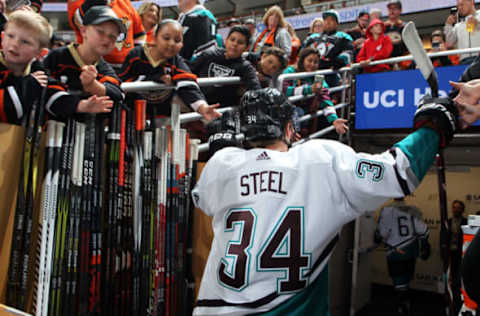
Sam Steel
Grade: B-
Twenty-year-old old Sam Steel, hailing from Sherwood Park, Alberta, Canada, was the Ducks first round pick in the 2016 NHL Entry Draft. He was selected 30th overall with the first round pick they acquired in the trade that sent goaltender Frederik Andersen to the Toronto Maple Leafs.
Steel is a smaller player, standing at only 5’11” and weighing 186lbs. Steel was a prolific player in junior hockey, playing 5 seasons (4 full seasons and a 5 game stint to start his career) with the Regina Pats. During his tenure with the Pats, he posted 338 points in 258 games played. This included an outstanding season in 2016-17 that saw him score an absurd 131 points in 66 games on route to being named the WHL player of the year.
Steel is billed as a playmaker with top end hockey IQ. He has a knack for scoring goals while remaining responsible defensively. Steel has decent skating ability, with a mid-high end speed and unmatched creativity with the puck. His weaknesses lie almost entirely in his size, seen by many as too small to be an effective center at the NHL level.
Many believe, because of his size, a position on the wing would suit him better. Paired with a sub-par face-off ability, it seemed likely that Steel would follow a bit in the tracks of Rickard Rakell, another player drafted a center, who has found a nice home on the wing.
Steel played all three games for the Anaheim Ducks during the first week of this season. He started the season against the San Jose Sharks, centering a line with Jakob Silfverberg and Pontus Aberg, who the Ducks acquired via waivers the week of the start of the season.
The first game was an unforgettable moment for Steel surely but it was a relatively forgettable performance. Steel looked nervous, and a bit outmatched by the Sharks, as did much of the roster. The center played just over 13:00, not registering a shot, and despite being on the winning side of a 5-2 game, ended the game with a minus 1 rating and finished 8/17 in the face-off dot.
The second game was Steel’s most productive as on the stat sheet. He logged 15:36 of time on ice, 3 shots on goal, as well as winning the same amount of face-offs, in fewer attempts going 8/13, winning 61.5% of his draws. Steel looked more comfortable during this game, playing a more aggressive game offensively while remaining responsible defensively. Steel showed promise in the offensive zone making more plays and, while he didn’t show up on the stat-sheet offensively, gave fans plenty to be optimistic about.
In terms of the stat sheet, it was more of the same from Steel in game three. There were no points for Steel, no logged shots on goal, and he had his worst face-off percentage to date despite playing over 20 minutes, including an overtime period. The eye test told an entirely different story, however. Steel looked dominant at times making slick plays with the puck, finding his teammates with passes that were of high difficulty, and showing off another gear to his skating.
Steel’s best game so far certainly has been his third game. Steel showed fans why he was so highly regarded by management and, if this is a sign of things to come, he will be a very fun player to watch for the foreseeable future.
I’m going to give Steel a B-. If we grading the rookies game by game, he would get an A for the third game of the season. Overall, I feel a B- is sufficient, he played well and is playing a difficult position to adjust to at the NHL level as a center.
He has yet to really jump out on the stat sheet only tallying 3 shots on goal through 3 games (all of which occurred during the same game) and his overall face-off win percentage is decent, but not earth-shattering, at 51%. Steel has promise and I think he will have a coming out party soon enough.
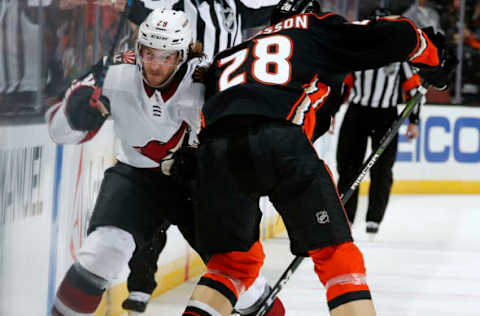
Marcus Pettersson
Grade: C+
The 22-year-old defenseman from Skelleftea, Sweden, had a relatively lengthy stay in Anaheim last year, playing 22 games in the regular season and all four games in the playoffs for the Ducks.
Selected in the second round of 2014 NHL Entry Draft by the Ducks, Marcus Pettersson looks to add to the long history of Ducks defenseman who seamlessly transition to an NHL role. Pettersson looked comfortable in his first stint with the Ducks towards the end of last season, earning Carlyle’s trust and finding a niche on the 3rd pairing.
Pettersson is a solid two-way defenseman, who is not flashy but is responsible on both sides of the puck. Pettersson is a solid skater and while he isn’t elite at any one specific area of the game, is a bit of a Swiss (or Swedish?) army knife as he can, at the very least, be sufficient in any role he’s put in. Pettersson is a fairly low ceiling defenseman but he’s safer than most, in that it’d be surprising if he, at the very least, did not maintain his current position as a 3rd pairing guy.
Pettersson played all three of the Ducks games through the first week of the season, slotting in on the 3rd pair with either Andrej Sustr or Luke Schenn. In the first game against the Sharks, Pettersson logged 14:13 of ice time. He didn’t manage to show up on the score sheet on the offensive or defensive side of the game. He simply just played his game and succeeded in doing so. However, he may have been dragged down a bit by a fairly bad performance by linemate Luke Schenn.
Pettersson’s second game against the Coyotes may have been the young Swede’s best thus far. It may have bee helpful that he was paired with Sustr who, thus far, has been a better defenseman than Schenn. Pettersson played less, logging 14:06, but he made the most of the time, securing a shot, a hit, and 3 blocked shots.
During the defenseman’s third game he has paired with Schenn again. It was a slightly better game than his first go-round with his linemate. The pair seemed more cohesive, and despite playing a more sheltered 11:23, Pettersson did manage to block 2 shots. Pettersson didn’t stand out, in any good or bad way specifically.
Overall, I’d give the defenseman a C+. Pettersson has been solid thus far, although he hasn’t had any standout moments. He’s been a decent 3rd pairing defenseman, and for a player in that role, not being noticed at all is not necessarily a bad thing. However, he didn’t do quite enough to deserve a higher grade. His consistency has been admirable and long-term, he will be an asset to the team.
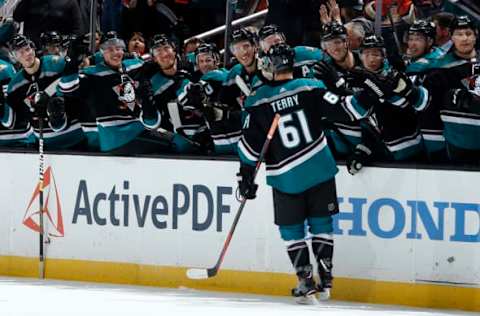
Troy Terry
Grade: C
The 21-year-old, Denver native and Olympic hero, was selected in the 5th round of the 2015 NHL Entry Draft by the Anaheim Ducks. Troy Terry plays a slick two-way game without being too flashy. He’s a lanky player standing at 6’1” while being billed at 178lbs. He’s a smooth skater with a good shot, smooth passing ability and a willingness to go to the corner to battle for pucks.
Despite his lankiness, Terry is not afraid to play physically, constantly seen battling down low in puck battles. Terry doesn’t have a ton of downside to his game, however, his biggest knock would most likely be a lower skill ceiling than most of the others on this list. Terry is responsible offensively and defensively and will be a useful piece in the NHL for the foreseeable future, but he doesn’t have the game-breaking ability that some of the higher ceiling players have. Despite that, his poise under pressure is admirable and an asset that can’t be taught.
Unlike Comtois, Steel, Sherwood, and Lundestrom, Terry is one of the two Ducks who has played a game at the NHL level prior to opening night. He finished with the Ducks last season after signing a three-year deal. So while he only played in 2 games last season, it seemingly helped some of the growing pains of adjusting to the speed of an NHL game.
The first game of the season Terry played on the top line with Getzlaf and Rakell. He was on the ice for 15:35 and didn’t contribute much on the stat sheet. He didn’t have any points, hits, or penalties. He looked composed and made some nice plays with the puck. Terry didn’t seem to have the jitters that some of the other guys had on opening night and he always seemed to be in the right place position wise, even if it didn’t generate much offensively. A decent first game but nothing to write home about.
The second game of the season Terry saw his ice time dip a bit to 14:15. He continued to look comfortable, but he didn’t produce much on the score sheet again. He did, however, manage to get 2 hits and a blocked shot. Terry continues to look like he belongs, no glaring issues with his game, but he’s yet to show a true landmark moment that makes his spot on the roster solidified through two games.
The third game was much of the same through regulation and overtime, managing his first 2 shots on goal of the season, and blocking a shot, Terry didn’t contribute much else on the score-sheet. Terry did manage to shine during the shootout though. Facing Jimmy Howard, with the chance to put the Wings on the ropes, Terry rifled a shot through the 5-hole that put the Ducks on top. The Olympic shootout hero reprised that role in the NHL helping the Ducks get the win.
His performance so far has earned the young forward a C. Terry has the skills to be a valuable asset to the Ducks. He’s a complete player and is rarely out of position. Unfortunately, at this point of the season, he’s yet to find chemistry with one of the Ducks lines and hasn’t been able to contribute the way that the fans would like him to.
The season is still very young and I have faith that Terry will turn it around on the stat-sheet. Nevertheless, as of this moment, three games into the season, Terry hasn’t exactly shown a reason that justifies him being in the top 6 role he currently occupies.

Max Comtois
Grade: A+
The 19-year-old left winger, hailing from Longueuil, Quebec, was selected in the second round by the Ducks in the 2017 NHL Entry Draft. That year the Ducks didn’t have a first round pick due to the trade for Patrick Eaves. Selected with his best friend Antoine Morand, Max Comtois has been seen as the epitome of a “boom or bust” pick.
Considered to have top 10 talent, his draft year severely hurt his draft stock. Comtois scored a career-low 51 points for the Victoriaville Tigers, displaying a concerning lack of discipline, taking several bad penalties.
Comtois plays a physical game but has soft hands and an impressive shot. Comtois is a big body, standing 6’2” tall and weighing 207lbs. He is surprisingly quick for someone considered a “power forward.” He has average to above average puck skills and average defensive ability. Comtois’ biggest negative was his lack of discipline, not uncommon for power forwards. The real question is whether the player can skirt the razor-thin line between “gritty” and “undisciplined”.
Max came into this season with relatively low hype from fans. A lot of people compare him to Nick Ritchie, and after his disappointing season, some fans saw Comtois in a similar light. This is, however, a comparison I don’t particularly agree with. Nevertheless, Comtois impressed in camp and had a modest rookie tournament. His preseason showed remarkable growth and, in some ways, he ultimately forced the Ducks to give him at the very least, a tryout with the big club.
Comtois played all three games through the first week of the season, starting the first game against the Sharks on a line with Adam Henrique and Jakob Silfverberg. It didn’t take Comtois long to establish himself in the NHL scoring a goal on his first NHL shot, 49 seconds into the game.
The young winger scored five-hole, a shot that surprised Jones and put the Ducks up 1-0, in a game they eventually ended up winning 5-2. Comtois played a relatively sheltered 11 minutes, ending the game with 2 shots on goal, the first goal of the Ducks season, an even plus-minus rating, and 1 hit. He looked slightly more composed than Steel but, at the same time, he was playing with more established linemates and wasn’t taking face-offs.
Comtois played the second game, against the Coyotes was on the same line as the first. He looked more comfortable, which resulted in his play time increasing to just over 16 minutes, culminating in the Ducks first goal at the 19:27 mark of the 2nd period. His second goal of the season, another five-hole shot, squeaked under Raanta. Comtois finished the game with a +1 rating, 2 shots, 4 hits, and a blocked shot as the Ducks shut out the Coyotes 1-0. An impressive showing for Comtois as he seemed to get more comfortable as the game went on.
Comtois’ third game saw the Ducks face off against the Red Wings in the Ducks home opener. Like Steel, this wasn’t Comtois’ most productive game on the stat sheet but was arguably his most impressive. Finishing the game with an assist, a +1 rating, his first minor penalty, and a slight increase to his ice time, playing 17:45. One thing that was more on display this game was Comtois’ physicality. Finishing the game with an impressive 7 hits, Comtois was throwing the body around much more freely as he seemed to settle in and thus took more risks. An impressive outing overall for Comtois.
I think it’d be difficult to give Comtois anything but an A+. He’s slotted into a top 6 role for the Ducks, he’s started his career on a 3 game point streak that includes goals in his first 2 games, and he’s playing a physical gritty game thus far. If Comtois has truly found the line between being physical and being undisciplined the Ducks could have struck gold with Comtois. He has certainly impressed thus far and will be one to watch as the season progresses.
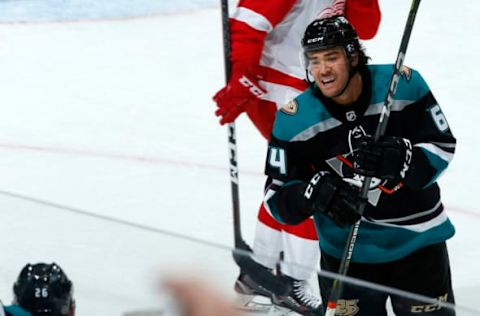
Kiefer Sherwood
Grade: B-
Kiefer Sherwood is the oldest of the Ducks rookies, at 23-years-old. He also is the only one who was not drafted, signing as a college free agent with the Ducks late last year. Sherwood came into camp with relatively low expectations, seen by most as a lock to start the season with San Diego of the AHL. The 6’0” 194lb winger had other plans, impressing coaches and fans alike with his quick play and soft hands.
Sherwood has good skating ability and a nose for the net. He has good playmaking ability and good vision. When it comes to the downside, Sherwood has two knocks on his game. He’s a smaller player in stature, similar height and weight to Steel, being 3 years Steel’s senior, and he has a somewhat weak shot.
He has a pretty accurate shot but seems to struggle to get velocity behind the shot. Neither is unfixable and if Sherwood can make up for his shortcomings with his speed and passing, he shouldn’t have a problem finding a spot on an NHL roster full-time.
Sherwood played all three games through the first week of this season, mostly in a bottom six role. His first game against the Sharks, he looked a bit lost at times, having trouble adjusting to the speed of the NHL game and having trouble making an impact.
Some of this could be due to playing with Ben Street and Carter Rowney who are not exactly top end talents, and some of it could be nerves which is understandable when you’re making your NHL debut. Sherwood did play a surprisingly high 13:50, the second most among rookie forwards in the season opener. Sherwood finished with 2 shots, one hit, and an assist on Carter Rowney’s empty net goal. A promising start for the Columbus Ohio native.
The second game Sherwood got bumped up the lineup to play with Steel and Cogliano due to a lackluster performance by Pontus Aberg that saw him scratched. Sherwood looked more comfortable overall, playing a faster game, in part because he was playing with a more skilled line. He finished the game, as many of the Ducks did, without any points, 2 shots on goal, a blocked shot, and a hit. He saw his ice-time take a small hit, playing 12:54 on route to the Ducks 1-0 win.
During game three Sherwood, like the other Ducks rookies, looked at his most comfortable, playing a much faster game. Sherwood was more dynamic offensively and noticeably more daring with his puck movements, which opened up the ice a bit and helped the Ducks generate more offense. He finished the with his most time on ice so far logging 15:34, in which he managed 1 shot on goal and a helper.
Overall I feel Sherwood deserves a B- grade. While he does have more points than Steel, it’s important to note that one of his two points occurred as an assist on an empty net and his second assist was a secondary assist. While it’s impressive and promising, it’s slightly deceiving. Sherwood has played well and overall has been impressive, but his tentativeness in the first game lowers his overall grade a bit.

Isac Lundestrom
Grade: A-
The 18-year-old Swede was selected by the Ducks in the first round, 23rd overall, of the most recent draft. Lundestrom was seen by many as a “safe” pick. One of the more sure-fire NHL players, but considered to have a low ceiling.
More from Ducks News
- Who could the Anaheim Ducks consider presenting offer sheets to?
- Is Pierre-Luc Dubois on the cards for the rebuilding Anaheim Ducks?
- Making the case for the Anaheim Ducks to trade with the Edmonton Oilers
- Anaheim Ducks might benefit tremendously by trading John Gibson
- How close are the Anaheim Ducks to becoming contenders again?
Standing at 6’0”, the187lb center is a very responsible defensive player. He has surprising speed and agility. The Swede has a solid shot and puck skills paired with above average passing. Overall, Isac Lundestrom seems like he could end up being the total package for the Ducks.
The team was very high on him and gave him every opportunity to succeed thus far. He stood out in the Ducks rookie tournament in Vegas, training camp, and preseason. Lundestrom made it almost unthinkable to send him back to Sweden for another season, the last test to see whether he will last in the NHL this season or not was playing in the regular season.
Lundestrom’s debut in the NHL was delayed by two games, making his debut at the Ducks home opener against Detroit. He made a quick impression with his strong skating and puck skills. The biggest highlight of the night was a slick zone entry, beating the defense into the zone and creating a scoring chance.
While the young center didn’t manage to score on that play, seconds later Lindholm managed to fire a beautiful shot on goal that gave the Ducks the lead. The goal was all started by Lundestrom’s great zone entry. He didn’t do much that showed up on the score sheet for his debut. Playing 14:23 and managing 1 shot, he was a +1 and managed to win 50% of his faceoffs. Lundestrom showed a lot of promise and the team itself, and Ducks Nation should be excited about.
Lundestrom has played the least out of the players mentioned here, giving him an A- grade. However, in the short time, we have seen from him he’s been remarkably impressive. Lundestrom is making it a very difficult decision regarding his future for the team. It’d be hard to justify sending him back to Sweden given his strong play, and if he is sent back, I can’t help but think he’ll be by far the most likely to make the roster next year.
Anaheim Ducks Rookie Conclusions
Overall, the Ducks have a lot of promising rookies on their hands. They have filled a lot of roles and holes that the team needs to fill. They have safe picks, they have boom or bust picks, they have defensemen and forwards, they have power forwards and playmakers, they have players with grit and they have players who rely more on skill.
It’s an incredibly promising start to the Ducks season and the rookies are a huge part of that. What happens next is yet to be seen. It’s most definitely an exciting time to be a Ducks fan and looking ahead to the future when Getzlaf, Perry, Kesler may not be the franchise building blocks, is a lot less scary than it was this time last season.
Next. Top Five Players to Replace Nick Ritchie. dark
There are a lot of games left to play this season. Which rookies on this list do you think to secure themselves a roster spot for the rest of the year? Do you agree with our analysis? Let us know by leaving a comment below or finding us on Facebook and Twitter!